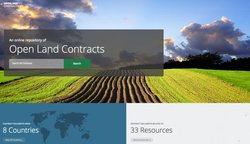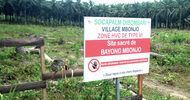Land Portal | 21 September 2016
Land Portal launches innovative dynamic country portfolios based on linked open data
Land Portal launches innovative dynamic country portfolios based on linked open data
For more information, please contact: Neil Sorensen at +33641668648 or [email protected]
GRONINGEN (21 September, 2016) — Land has become a key issue on the global development agenda in response to large-scale land acquisitions by foreign investors, rapid urbanization and population growth in developing countries. Amidst global calls for community and indigenous land rights, the formalization of tenure systems and indicators on land in the 2030 Agenda for Sustainable Development, the Land Portal today is launching innovative dynamic editorialized country portfolios based on Linked Open Data to provide access to extensive data and information on land issues.
“This launch represents a significant step towards realizing the Land Portal’s objective of increasing access to information for all land governance stakeholders, particularly those in the Global South,” said Leon Verstappen, Chair of the Land Portal Foundation. “In an effort to inform debate on local, national and global levels, the Land Book country portfolios contribute to improved land governance through information and knowledge sharing.”
Featured in this launch are country portfolios for the Mekong region, including for Cambodia, Laos, Myanmar, Thailand and Vietnam. These portfolios were enriched in partnership with Open Development Mekong, which provided detailed country narratives from local perspectives as well as local content. These portfolios will be further developed in partnership with Mekong Region Land Governance, based in Ventiane, Laos, and Mekong Land Research Forum, based at RCSD (Regional Center for Social Sciences and Sustainable Development) in Chiang Mai Unversity in Thailand.
The Land Portal is a Linked Open Data platform, which means enriching, connecting, and linking data in structured, machine readable and standardized formats under open licenses. This is a highly innovative approach, and with this launch the Land Portal remains on the cutting edge, building capacity among local partners to share their own data in Linked Open Data format and to integrate information from the Land Portal on their own platforms.
Additionally, in an effort to address the lack of a standardized approach and to improve the discoverability of land-related information through Linked Open Data, the Land Portal has adopted a strategy to standardize metadata – the information that describes the content, for land-related information using a standardized vocabulary called LandVoc, the Linked Land Governance Thesaurus, which is primarily derived from the Food and Agriculture Organization of the United Nation’s (FAO) Agrovoc, the standard vocabulary for agriculture, enriched with land-specific terminology.
“LandVoc is in an embryonic phase and will require further resources to fully develop, but through capacity development and participatory processes, it will lead to a better vocabulary for the land community and should come to serve as the backbone of the Land Portal by making land information much more discoverable on a global level, “ said Laura Meggiolaro, Land Portal Coordinator.
Land Book country portfolios currently integrate datasets from the Food and Agriculture Organization of the United Nations (FAO), the Global Donor Platform for Rural Development, the International Food Policy Research Institute (IFPRI), the Land Matrix, the Organization for Economic Cooperation and Development (OECD), the Rights and Resources Initiative (RRI), the United Nations Development Program (UNDP) and the World Bank, including 361 indicators covering everything from access to conflict resolution to women’s land rights.
In addition to the detailed country narratives, the portfolios include a table of standard globally relevant indicators with their year, value, unit and other information, and the possibility to add any number of indicators chosen by the user.
Next, a graph allows users to compare available indicators multiple countries or to map indicators globally in an appropriate format relevant to the indicator.
Each portfolio also includes a series of infographics. The first infographic, which is dynamically adjustable, presents the World Bank’s Land Governance Assessment Framework (LGAF) in a stoplight format, on a scale of red representing very weak practice to green representing very good practice. Additional infographics include a breakdown of land use and the main global development indexes represented on a spider chart to demonstrate where each country stands in terms of global hunger, human and social development and income distribution.
“We realized that in order to make content truly accessible, we needed to make the information not only machine-readable, but human readable,” said Marcello Demaria, Land Portal Researcher. “Making data open was the first step in the process. We needed to make the information searchable, while making the data and information easy to use, understand and visualize.”
Portfolios now also include the latest news, events, debates and blogs relevant to the country, as well as links to Land Portal partner organizations. Moreover, the portfolio includes a searchable set of Land Library resources from the country.
These portfolios provide a solid foundation for future development of the Land Book, which includes the integration of additional globally relevant information and expansion of the number of countries with complex country-specific portfolios. Among these future developments is the inclusion of innovative new infographics that provide color-coded legal data that measure whether national expropriation laws adopt the international standards established in the Voluntary Guidelines on the Responsible Governance of Tenure (VGGT). Legal data provided will be directly linked to provisions established in Section 16 of the VGGTs on expropriation, compensation, and resettlement, including a table with all relevant land legislation and regulations.
Crucially, the Land Portal intends to track progress towards progress towards achieving the 2030 Sustainable Development Agenda indicators relevant to land, including 1.4.2 on the proportion of the adult population with secure tenure rights, indicator 5.a on women's land rights, 11.3.1 on the rate of land consumption to population growth and any other relevant indicators that materialize from the finalization of the provisional SDG indicators.














